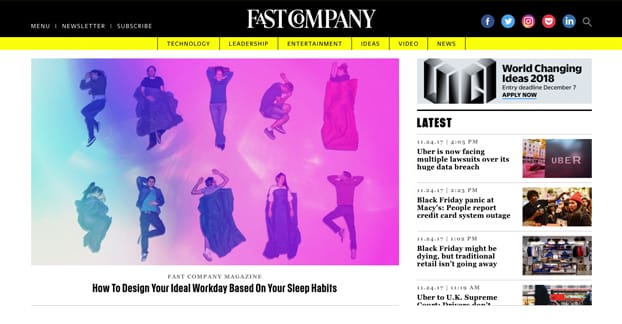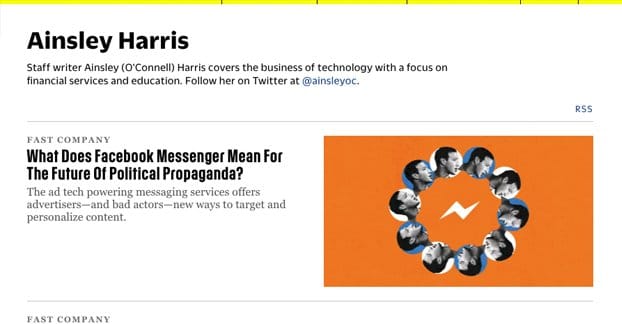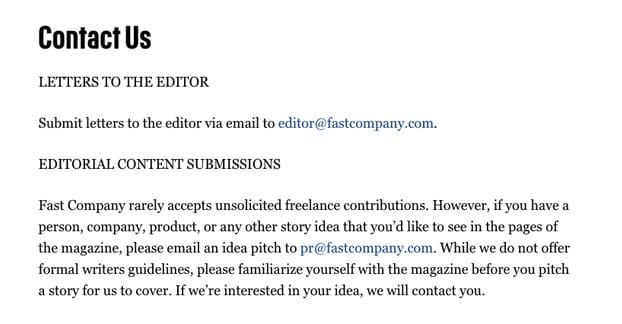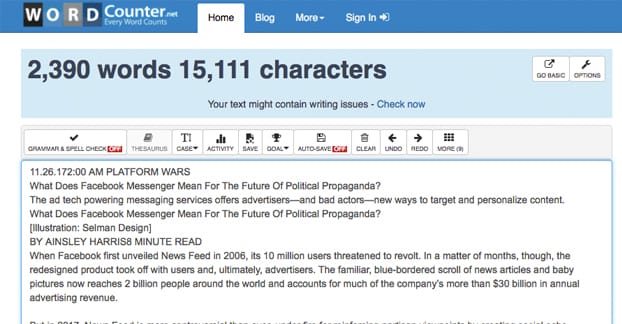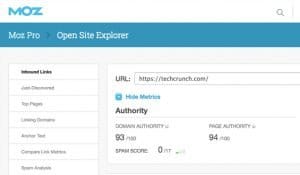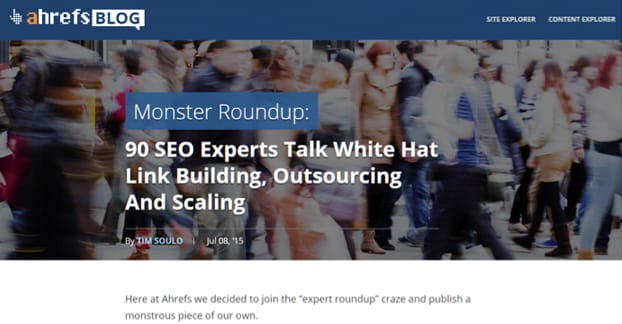Fast Company is an interesting magazine and website. Many of the larger business and technology websites that have magazines were, well, older and established magazines long before they became web properties. Fast Company, meanwhile, launched both their website and their magazine in 1995.
Over the intervening 22 years, Fast Company has grown to a respectable size. Both the magazine and the website are focused on the same topics, which circle around business topics. They write about a very wide range of business-related content. Here’s a selection of what I see browsing their page as I write this:
- A social business article about being LGBT and out publicly at work.
- A post about the acquisition of Musical.ly for a billion dollars.
- A resource guide for veterans returning to the workforce.
- A post about the influence of Instagram on the Russian propaganda campaign.
- A guide to job references when your relationships aren’t necessarily good.
Everything centers around business. Some topics are broadly news, like the Musical.ly acquisition. Most, though, are either tied into current events – like the veterans post for Veteran’s Day or the Russian thing – or are focused on how businesses are adapting to modern culture. Agile businesses and responsive practices are important areas to cover.
If you want to contribute to Fast Company, I have good news and bad. The good news is that you can, potentially, contribute an article. The bad news is that it’s rare that they actually accept guest posts, so you have to be very well aligned with their content and their attitudes if you want to contribute.
Step 1: Read Fast Company
Fast Company is one of the pickiest and most focused sites around when it comes to guest posts. They may cover a wide range of different subject, but it’s always through the lens of business. Every single subject is about how a business is adapting to something, how a business is changing or revolutionizing something, how a business is breaking barriers – or the opposite, how a stodgy business is failing because they won’t adapt to the times.
I recommend spending at least a month reading most of the content that reaches the front page of Fast Company. There’s a lot of it, and it will take a while to go through, but it will give you a good idea of what kind of content they like to publish.
If you’re inspired by anything you read and think “hey, my company does something like that,” good. Write that idea down. You might be able to use it later.
Pay special attention to the Leadership channel. This is where 99% of all guest contributions are published, and will more closely match the voice, tone, and topics that Fast Company is willing to publish. Not all contributions in Leadership are guest contributions, but virtually all guest contributions are in Leadership. They range in topic from how to start a side business to how to find a job without going through the usual channels, to innovative ways people are networking.
Step 2: Take a Look at Yourself
Now that you have a general idea of what Fast Company likes to publish, you can take a look at your own business and try to figure out ways you might be able to leverage your experiences into a guest post.
See, unlike most other sites, guest posting for Fast Company does not rely on your knowledge. Instead, it relies on your experiences. It’s not something you can fake, because much of what Fast Company talks about is verifiable information. You can’t claim that your company is taking steps to increase inclusivity in the workplace, while being a one-man operation working out of a spare bedroom.
Don’t think you can just look to the news and cover something from there, like the ongoing Russia stuff or the #MeToo sexual assault storm, or even just a company acquisition. Fast Company has their own staff reporters to cover the news.
So what do they want from you? One hint lies in a Quora answer from a former Fast Company staff member.
“One answer to this question can be found in the two questions I’d ask every person that pitched me (including myself when I was pitching a story to an editor):
- What do you or your company do that is changing your industry?
- What do you or your company do that is/will change other industries?
If you have solid answers to those two, your chances of getting written about are strong.”
There are a few things worth noting here. First of all, the finale. “Your chances of getting written about,” not your chances of writing for the site. It’s actually a lot easier to get coverage on Fast Company than it is to contribute text yourself. If you want to submit a tip about your company, or offer yourself for an interview or coverage, you can do so with greater ease than you can write a post for the site yourself.
Second, both questions rely on you being able to change your industry or have some form of influence on it. If you’re just one of a dozen companies with nothing to differentiate you from the rest, what do you have to offer that Fast Company would want? The answer is, unfortunately, probably nothing.
If you’re in a position where, as a business, you are not able to answer either of the two questions above, you only have one possible course of action. That course is to find something squarely within your area of expertise and go all-in on making a resource out of it. That post I mentioned with resources for veterans returning to the workforce? That’s one example. It’s a lengthy, detailed guide with a lot of links to specific programs, not vague “check with your state to see if they have a program you can join” platitudes.
If possible, consider tying your idea into some upcoming event or holiday. I would guess that the veterans post was written months before Veteran’s Day, and was simply scheduled to be published on time. You need to leave enough of a lead time for editors to look over your work, for revisions, and for room to be made in the editorial calendar.
Step 3: Read the Guidelines
Fast Company has a single lone article about contributing to their magazine. It was published in 2013, and has since been updated as information changes. Let’s go over it.
First of all, as I mentioned up above, guest contributions are selectively accepted, rare, and almost exclusively published in the Leadership section. What does Fast Company look for?
As you might expect, you want to match the tone and substance of existing Fast Company content. “Articles submitted for consideration should be of interest to Fast Company readers, have a tone that is appropriate for Fast Company, and be written by a person, not a PR department.”
Fast Company prefers articles that cover topics they don’t commonly see. They like new ideas, new advice, and outside-the-box thinking. They like to not just start conversations, but to advance them to the next level. While everyone else is debating the relative merits of A and B, you can accept A and figure out how A and C build to make D. Take things one step beyond.
Your writing needs to have a solid voice. They like writing that is lively and balances “research or news with fun and memorable anecdotes or examples that help illustrate your point of view.”
There’s a fine line you have to pay attention to when pitching content to Fast Company. They heartily encourage you to draw upon your own business experiences to form the basis of your article, but you are not allowed self-promotion. The typical “write about yourself for a link” style of guest post will not be accepted, I guarantee it. If you’re writing about your own business, you’re doing it because of a policy or a perspective you bring to the table, and you should likely avoid mentioning what you do or what your product is.
In fact, if you mention anything like a non-sequitur “which, by the way, we have a sale on” it’s a pretty much guaranteed rejection. You might not even be asked to revise it; if you’re going to try to sneak something like that into a guest post, they might as well just not work with you.
Fast Company is read by a wide variety of people in different industries and businesses of all sizes. You should avoid filling your article with jargon, technical details, blanket assertions, or references only people in your industry would get.
The list of key words and topics they cover in Leadership, in case you weren’t able to suss them out on your own, are as follows: productivity, creativity, career development, hiring, recruiting, work culture, work-life issues and policies, entrepreneurship, and innovation. Regardless of topic, you should generally aim to write something with a tangible takeaway value for the people who read the post. Remember, most of the people reading will be in leadership positions themselves, looking to learn and improve their own businesses.
As for the technical guidelines, article should be between 750 and 1,000 words. There are many longer posts on their site, even in the Leadership section, but often those are written by proven contributors. I recommend following their instructions; not doing so might get you rejected for not reading the guidelines, regardless of the value of your post.
DO NOT SEND PITCHES. This is where many sites differ from Fast Company. Fast Company prefers that you send complete, unpublished articles only. You are not allowed to send an article that has been published elsewhere, and you cannot publish the article elsewhere after it has been accepted for at least a week. Don’t send outlines, don’t send interview offers, don’t send press releases, and don’t call them on the phone.
Check with this post (linked again) for information on whoever their current editor in charge of submissions happens to be. As of this writing, it’s Anisa Purbasari Horton. Keep this in mind when writing your submission.
Step 4: Write Your Post
I’m just going to gloss over this section, because we’ve written a lot on this site about how to write a good guest post. You should know by now to put your best content forward. Strive to be innovative and interesting for Fast Company; the bog-standard opinions and content topics won’t pass muster.
When your post is ready for submission, make sure to review it again just to make sure you’ve caught all of the typos and mistakes. Get someone else to review it or run it through a strict grammar check if necessary.
You can submit your content in general to submissions (at) fastcompany (dot) com. If you believe that your content might have a space in a different vertical other than the Leadership channel, you’re free to send your submission to the editor of that section, as determined by their masthead. Keep in mind that other editors do not regularly review their submissions, so sending a post their way might take months to hear back.
Fast Company goes through their submission inbox about once a week and selectively chooses the few they want to pursue. If they do not accept your post, you won’t hear back from them. If they do, they will send you a response within a week to a week and a half of submission. Following up does nothing but clutter their inbox, so don’t do it. They also won’t give you feedback on a rejected post; it’s just silence from the void.
If they do accept your post, they are free to edit it, including changing the headline and subheads. They can edit for style, for tone, or for substance, and they can add links. You don’t have to worry about art; they’ll cover that.
If your post is accepted, you can expect to receive promotion and possibly syndication on other Fast Company affiliated sites, like Co.Design or their newsletters. Good luck!
 ContentPowered.com
ContentPowered.com

